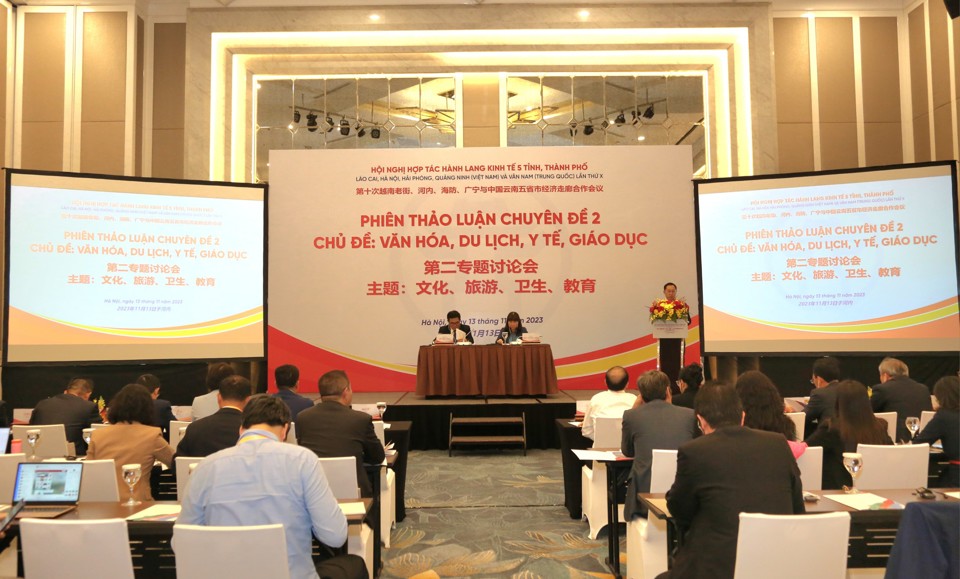China is key tourism market to Vietnam: officials
Provinces and cities along the Vietnam-China Economic Corridor aim to achieve a total trade value of US$5 billion.
China is the most important source market for Vietnam's tourism sector and Hanoi, said Dang Huong Giang, director of the capital's Department of Tourism, on November 13.
Giang said the number of tourists arriving in Hanoi and other Vietnamese cities and provinces has increased in recent years.
| Discussion on tourism, culture and health cooperation between Yunnan and Vietnamese localities on November 13. Photo: Thanh Hai/The Hanoi Times |
China has always been the top priority market for Hanoi and other Vietnamese provinces and cities to explore, she said during a discussion at the 10th Vietnam-China Economic Corridor Cooperation Conference.
"The number of Chinese tourists visiting Hanoi and Vietnam accounted for about 30% of the total foreign visitors before the Covid-19 pandemic," Giang said.
According to the Hanoi Tourism Department, nearly six million Chinese arrived in Vietnam in 2019, up 17% from the previous year. Of these, Hanoi welcomed nearly 800,000, accounting for 16% of the city's international arrivals.
From January to October 2023, Hanoi welcomed about 210,000 Chinese visitors. These travelers accounted for 10% of the city's total foreign tourists.
Meanwhile, Vietnam is one of the top five outbound markets for Chinese, with some eight million tourists traveling from Vietnam to the latter in 2019, up 4.8% year-on-year.
"Vietnamese and Chinese localities in border areas have been looking for ways to strengthen their ties in tourism," Giang said.
Do Dinh Hong, director of Hanoi's Department of Culture and Sports, said decentralized relations between Vietnamese and Chinese localities had made progress, contributing to strengthening the two nations' "two corridors, one belt" mechanism.
The two sides have worked together to make the best use of their advantages so that Yunnan and four Vietnamese localities have reached a trade value of US$5 billion, he said.
A highlight of the bilateral relations between Yunnan and four Vietnamese provinces and cities was the launch of the "Two Nations, Six Destinations" tourism program in March 2023.
At the conference, the Lao Cai Provincial Tourism Department recommended a new program called "Two Nations, Multiple Destinations" to promote travel between Vietnam and Yunnan.
The department urged the governments of Vietnamese provinces and cities and Yunnan to find solutions to speed up immigration procedures for tourists.
The department also suggested that the Vietnamese government allow Chinese citizens to enter and travel through Vietnam under specific conditions of the "Two Nations, Six Destinations" program.
The Quang Ninh Provincial Department of Tourism proposed to jointly promote the natural heritage of Ha Long Bay - Cat Ba Islands in Yunnan's Lijang City and vice versa.
The province also sought opinions on opening a new tour linking Ha Long Bay - Cat Ba Islands with other popular destinations in Yunnan Province, including Wenshan Zhuang and Miao Autonomous Prefecture.
Unmatched potential
There is room for improvement in the relationship between Vietnam and China and between Yunnan and Vietnamese provinces and cities, said Giang, director of the Hanoi Tourism Department.
| The first Chinese tourists in Vietnam arrived in March 2023 after the Covid-19 pandemic. Photo: Hoai Nam/The Hanoi Times |
She said the two sides should strengthen the exchange of delegates to share practices and experiences in cultural management, relic and heritage protection and cultural city development.
Giang suggested that provincial and municipal governments ease administrative regulations for travel companies and tourists.
Yunnan and Vietnamese localities can cooperate and exchange ideas on state-level management and provision of public health care and policy-making, and link leading hospitals in Hanoi with local facilities in the corridor, she said.
According to Yunnan officials, bilateral relations between the province and its Vietnamese counterparts have not reached their full potential. They said Vietnamese and Chinese authorities need to arrange more meetings between local officials to improve mutual understanding.
Since its establishment in 2004, the economic corridor has been an effective cooperation mechanism between the four Vietnamese provinces and cities of Lao Cai, Hanoi, Haiphong and Quang Ninh and China's Yunnan Province.
Key activities have been established and promoted in delegate and cultural exchanges, transportation connectivity, investment, trade and tourism.
Vietnam is now China's sixth-largest trading partner in the world. It is China's largest trading partner in Southeast Asia.
Chinese investors are now among the top 10 foreign investor communities in Vietnam. Their projects range from catering, hotels, consumer goods, textiles, footwear, mineral extraction and industrial parks.
Chinese investors are running more than 4,000 projects in Vietnam with a total registered capital of more than $26 billion, ranking sixth among 144 countries and territories investing in Vietnam.
The two economies recorded a total trade value of $175.6 billion in 2022. In January-October 2023, the figure reached nearly $139 billion.














